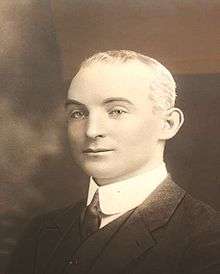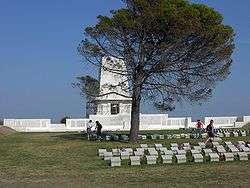Edward Larkin
Edward Rennix "Teddy" Larkin (3 January 1880 – 25 April 1915) was an Australian parliamentarian and a national representative rugby union player.[1] Larkin was the member for Willoughby in the New South Wales Legislative Assembly from December 1913 until his death. He served in the First AIF, and was killed in action on the first day of the Gallipoli Campaign.[2] He was one of only two serving members of any Australian parliament to fall in World War I — the other, who fell at Gallipoli on 4 May 1915, was George Braund, also a New South Wales MLA.
 MLA ER Larkin 1913 | |||||||||||||||||||||||||||||||||||||||||
| Birth name | Edward Rennix Larkin | ||||||||||||||||||||||||||||||||||||||||
|---|---|---|---|---|---|---|---|---|---|---|---|---|---|---|---|---|---|---|---|---|---|---|---|---|---|---|---|---|---|---|---|---|---|---|---|---|---|---|---|---|---|
| Date of birth | 3 January 1880 | ||||||||||||||||||||||||||||||||||||||||
| Place of birth | North Lambton, New South Wales | ||||||||||||||||||||||||||||||||||||||||
| Date of death | 25 April 1915 (aged 35) | ||||||||||||||||||||||||||||||||||||||||
| Place of death | Anzac Cove, Gallipoli, Ottoman Turkey | ||||||||||||||||||||||||||||||||||||||||
| School | St. Joseph's College, Hunters Hill | ||||||||||||||||||||||||||||||||||||||||
| Spouse | May Josephine | ||||||||||||||||||||||||||||||||||||||||
| Rugby union career | |||||||||||||||||||||||||||||||||||||||||
| |||||||||||||||||||||||||||||||||||||||||
| Military career | |||||||||||||||||||||||||||||||||||||||||
| Allegiance | |||||||||||||||||||||||||||||||||||||||||
| Service/ | |||||||||||||||||||||||||||||||||||||||||
| Years of service | 1914–1915 | ||||||||||||||||||||||||||||||||||||||||
| Rank | Sergeant | ||||||||||||||||||||||||||||||||||||||||
| Unit | 1st Battalion, Australian Expeditionary Force | ||||||||||||||||||||||||||||||||||||||||
| Battles/wars | First World War | ||||||||||||||||||||||||||||||||||||||||
Early life
Larkin was born at North Lambton, New South Wales, to William Joseph Larkin, a quarryman and his wife Mary Ann, née Rennix. His family moved to Camperdown in Sydney where the young Ted Larkin was schooled at St Benedict's Broadway, run by the Marist Brothers. For his last two years of senior schooling he boarded at St. Joseph's College, Hunters Hill, where he played in the college's 1896 first rugby XV.
After school he worked in journalism before joining the Metropolitan Police Force in 1903 as a foot-constable, later being promoted to first-constable in 1905.[3] His prematurely grey hair made him appear much older than he was.[4]
Rugby union career
He maintained an active involvement in sports after completing his schooling and participated in cricket, swimming and rugby union playing first grade with the Endeavour Rugby Club at Newtown in Sydney. In 1903 he was captain of that club and made his representative debut for New South Wales against Queensland and the touring New Zealand national rugby team before being selected for Australia in the first test of 1903 at Sydney on 15 August, against those same All Blacks. Larkin played hooker for the Australian representative side, in a pack featuring future rugby league pioneers and dual-code rugby internationals Alex Burdon, Denis Lutge and Bill Hardcastle. The Australians were soundly beaten 22–3.
Rugby league administrator
Larkin knew and sympathised with a number of the senior rugby union players who in 1906 and 1907 became louder in their discontent with the administration of the New South Wales Rugby Union, over rejection of compensation payments for injuries and lost wages. The breakaway in Australia took place in 1908, as it had earlier in 1895 with the Northern Union in Northern England. A gifted public speaker, Larkin had continued to develop a strong sense of social justice during his years in the police force. After the financial failure of the 1908–09 Kangaroo tour of Great Britain and claims of mismanagement by the League's founding fathers James Joseph Giltinan, cricketer Victor Trumper and Labor politician Henry Hoyle, the pioneer code looked to be in jeopardy before it had barely begun.
In June 1909[5] Larkin left the police force and was appointed the first full-time secretary of the almost bankrupt New South Wales Rugby League. He was an excellent organizer and had success in promoting the new game evidenced by the crowd of 42,000 who filled the Agricultural Oval in June 1910 to see the Australia v Great Britain Test. During his administration which lasted till 1913, he convinced the Catholic education hierarchy and the Marist Brothers in particular to adopt rugby league as their winter sporting game. The code benefits from this legacy to this day in New South Wales and Queensland.[6]
Parliamentary career
In December 1913 Larkin stood as the Labor Party candidate for the conservative seat of Willoughby winning 51.61% of the vote in a second ballot. He was living at Milsons Point at the time and became the first Labor Member of Parliament elected from the north side of the harbor. He was appointed as the government representative on the board of the Royal North Shore Hospital and was vocal in his support for proposal to build a bridge across Sydney Harbour[6] Larkin was the member for Willoughby in the New South Wales Legislative Assembly from December 1913 until his death.[7]
Active service and death
Ted Larkin's promising career was cut short with the outbreak of World War I on 4 August 1914. Demonstrating a patriotic fervor Larkin enlisted within ten days of war's declaration joining C Coy of the 1st Battalion, of the AIF's 1st Division. In his final address to the NSW Parliament, on 18 August 1914, Larkin said, "I cannot engage in the work of recruiting and urge others to enlist unless I do so myself."[8] Gray quotes a brief poem published in the Sydney Sun in 1918 acclaiming Larkin for his virtue in enlisting.
The battalion left Australia in October 1914, arriving in Egypt on 2 December. Larkin's brother Martin also embarked on the Transport A19 Afric for Egypt where Ted, a sergeant was active in promoting games of rugby league amongst the troops.

The battalion landed at Anzac Cove at dawn on 25 April 1915 as part of the second and third waves, starting the Gallipoli campaign. It took part in the desperate struggle for the dominating hill known as Baby 700. The Turks wrested control of the hill and counter-attacked to drive the Australians from the high ground. That afternoon Ted Larkin died from a chest wound in a hail of machine gun fire.[6][9][10]
Heads and Middleton quote from the war memoir Imperishable Anzacs by Harold Cavill: "Wounded and dying he lay, yet when the stretcher-bearers came to carry him in, he waved them on, saying 'There's plenty worse than me out there'. Later they found him dead". His brother Martin aged 37 also lost his life that day on the heights above Anzac Cove. Neither body was recovered until the burial Armistice of 24 May but there is no known grave for either of the Larkin brothers and their names are recorded on the Lone Pine Memorial commemorating 4,934 Australian and New Zealand troops killed in the sector who have no known grave.
In memoriam
Confirmation of Larkin's death didn't reach Australia until June,[11] whereupon a requiem mass was celebrated at St Mary's Cathedral, Sydney attended by many distinguished citizens including the Premier and the Governor of New South Wales. Ted and Martin were both awarded posthumously the 1914–15 Star, the British War Medal and the Victory Medal.
The 1915 Sydney rugby league City Cup grand final was held as a testimonial for Ted Larkin's widow and sons and raised £171. The St Joseph's College Old Boys' Union set up the Sergeant Larkin Bursary to help finance his sons fees at the college (at a meeting on 1 July 1915, the following resolution was passed: "That in order to commemorate the signal service of the late Sergeant E.R. Larkin, M.L.A., to Australia, the Union invite the co-operation of the all old boys to provide a bursary at St. Joseph's College for the deceased member's son").[12] The family eventually declined the offer but the bursary has survived to this day as the Old Boys' Bursary.
On 30 November 1915, in the New South Wales Legislative Assembly, the Speaker unveiled a commemorative tablet in honour of Lieutenant-Colonel George Braund, Member for Armidale and Sergeant Edward Rennix Larkin, Member for Willoughby who both fell at Gallipoli.[13] The plaque reads:
In time of Peace they readily asserted the rights of citizenship. In time of War they fiercely protected them."
Honours and awards
![]()
![]()
![]()
- 1914–15 Star
- British War Medal
- Victory Medal
See also
- List of Australian military personnel killed at Anzac Cove on 25 April 1915
- List of international rugby union players killed in action during the First World War
References
- "Scrum.com player profile of Ted Larkin". Scrum.com. Retrieved 12 July 2010.
- Lane, Daniel, "ANZAC hero Ted Larkin: The greatest sacrifice of all", The Sydney Morning Herald, (18 April 2015).
- Cunneen, Chris. "Larkin, Edward Rennix (Ted) (1880–1915)". Australian Dictionary of Biography. Melbourne University Press. ISSN 1833-7538. Retrieved 22 May 2019 – via National Centre of Biography, Australian National University.
- "Rambler", "Memory of 'Ted' Larkin, 'A Fellow of Infinite Jest', Brimful of Fun: Reminiscences of Some of Heroic Patriot's 'Interludes' Here and There", Referee, (Wednesday, 14 July 1915), p.12.
- Cunneen, Chris (2001). The best ever Australian Sports Writing. Australia: Black Inc. p. 321. ISBN 1-86395-266-7. Retrieved 19 February 2011.
- SJC News, article by James Gray p19
- "Mr Edward Rennix Larkin (1880–1915)". Former Members of the Parliament of New South Wales. Retrieved 11 May 2019.
- Masters, Roy (25 April 2014). "Enlisting Kangaroos were followed by NSW league players in their thousands". The Sydney Morning Herald. Fairfax Media. p. 44.
- "Welcome Home: Private Leserve's Story", The Sydney Morning Herald, (Monday, 26 July 1915), p.5.
- "Heroic Charge: Sgt. Larkin, M.L.A. Killed", Weekly Times, (Saturday, 2 October 1915), p.8.
- "Sportsmen and People Hard Hit by Heroic Death, in Action, of Sergeant Larkin", The Referee, (Wednesday, 23 June 1915), p.1, p.16
- "St. Joseph's College Old Boys' Unio(n): Bursary for Ted Larkin's Son", Freeman's Journal, (Thursday, 8 July 1915), p.24.
- FitzSimons, Peter, "Ted Larkin was an extraordinary man who should be honoured", The Sydney Morning Herald, (24 April 2014).
- St. Joseph's College News 2008 Volume 46, #2 article by James Gray, College Assistant Archivist
- Heads, Ian and Middleton, David (2008) A Centenary of Rugby League, MacMillan Sydney
- Williams, Terry (1993) Out of the Blue: The History of Newtown RLFC, Newtown RLFC, Sydney
- Williams, Terry (2008) Through Blue Eyes - A Pictorial History of Newtown RLFC, Newtown RLFC, Sydney
- World War One Service Record: Sergeant Edward Rinnex Larkin (321), National Archives of Australia.
- World War One Nominal Roll: : Sergeant Edward Rinnex Larkin (321), Australian War Memorial.
External links
| New South Wales Legislative Assembly | ||
|---|---|---|
| Preceded by Charles Wade |
Member for Willoughby 1913 – 1915 |
Succeeded by John Haynes |